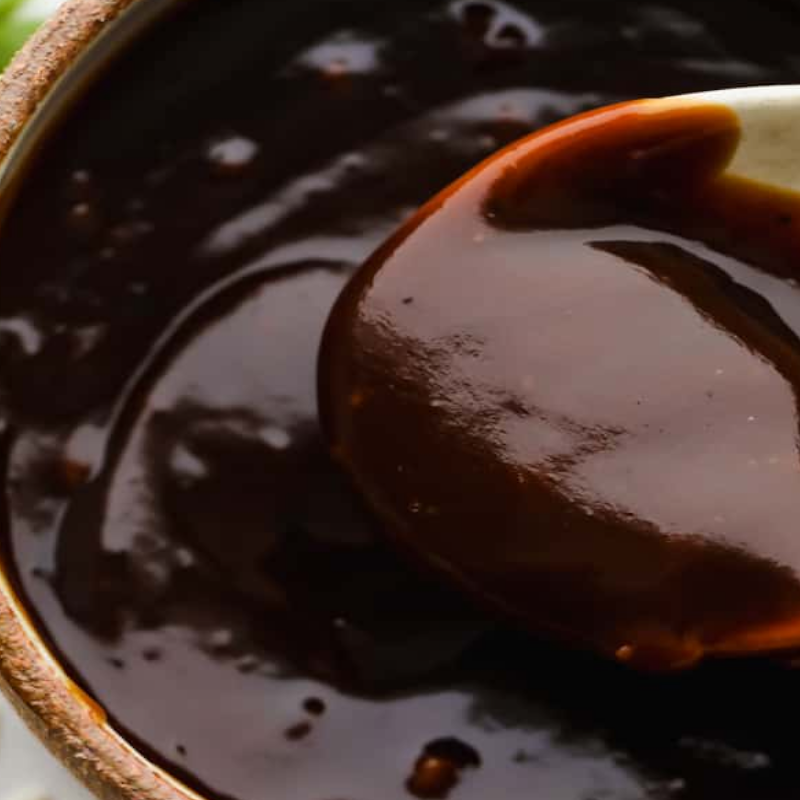Homemade Hoisin Sauce Recipe (Non-GMO, No Preservatives, Gluten-Free, Additive-Free)
 Garanties sécurité
Garanties sécurité
(à modifier dans le module "Réassurance")
 Politique de livraison
Politique de livraison
(à modifier dans le module "Réassurance")
 Politique retours
Politique retours
(à modifier dans le module "Réassurance")
Homemade Hoisin Sauce Recipe (No GMOs, Preservatives, Gluten, Additives…)
Uses of Hoisin Sauce
- Marinades: Used to marinate meats such as chicken, pork, or beef.
- Accompaniment: Served with dishes like spring rolls, nems, or Peking duck.
- Stir-Fry Sauces: Mixed with other ingredients to add flavor to stir-fried dishes.
- Toppings: Used in dishes like pho or bao (steamed buns).
It has a rich, slightly spicy flavor that pairs well with many dishes.
Origin of Hoisin Sauce
Hoisin sauce (海鲜酱, hǎixiān jiàng) is a traditional Chinese sauce, particularly associated with the Canton region, but also used throughout Southeast Asia. Its name, "hoisin," comes from the Chinese word for "seafood" (海鲜, hǎixiān), although the sauce itself does not contain seafood. The name may refer to the umami flavor that resembles fermented seafood used in coastal Chinese cuisines.
Hoisin sauce has its roots in the Chinese imperial dynasties, particularly during the Qing dynasty (1644-1912), when fermented soy-based sauces were popular. Over the centuries, it evolved into the modern version we know today: a sweet and spicy sauce that stands out for its rich flavor, perfect for marinating or complementing various Chinese dishes, such as the famous Peking duck.
History and Evolution
Originally, hoisin sauce was made from fermented soy paste and various seasonings, such as sugar, vinegar, garlic, spices, and seafood extracts. It was primarily used in Cantonese and Pekingese cuisine. Over time, it adapted in international kitchens, especially in the West, where it became popular in Chinese and Asian restaurants around the world.
Hoisin sauce has undergone an interesting evolution in Western countries, where variants without animal-based products have been created to meet the growing demand for vegetarian and vegan dishes. Thus, a modern version without monosodium glutamate (MSG), GMOs, gluten, and preservatives was created.
Homemade Hoisin Sauce Recipe (No GMOs, Preservatives, Gluten, Additives…)
Here’s the recipe for homemade hoisin sauce, completely natural and healthy, with no additives or preservatives.
Ingredients:
-
4 tablespoons of Kisoondo Doenjang soy paste
(Made with 100% non-GMO Korean soybeans and roasted bamboo salt. No preservatives or additives, no MSG, no fats, or cholesterol)
or
4 tablespoons of Jardin Bio peanut butter without added sugars
(or tahini for a peanut-free version)
(Peanut butter 100% peanuts, with no added salt, sugars, or palm oil). -
2 tablespoons of Astragalus Nebrodensis Sicilian Black Bee honey
or Bio Panela sugar
(Astragalus Nebrodensis honey is a rare mountain honey produced in the Palermo region in June. Its aroma is almost absent, and its flavor is delicate. Bio Panela raw, unrefined cane sugar, 100% natural, brings natural sweetness to the sauce). -
2 tablespoons of Oochi organic rice vinegar
(No additives: no preservatives or flavor enhancers like E620, E621, perfect for a pure and balanced taste). -
3 tablespoons of Tamari Igeta gluten-free soy sauce
(Tamari Igeta soy sauce is gluten-free. It’s non-GMO, with no additives or preservatives, ideal for those avoiding gluten). -
2 tablespoons of Vigean organic virgin sesame oil
(Adds a rich, lightly roasted flavor to the sauce). -
1 teaspoon of minced garlic
(For an aromatic and savory taste). -
1 teaspoon of chili sauce (optional)
(Adds a bit of spiciness depending on your preference). -
1 pinch of Chinese five-spice powder (optional)
-
1/4 teaspoon of ground black pepper
Instructions:
-
Mix the Ingredients:
In a bowl, combine the soy paste, honey (or sugar), peanut butter, rice vinegar, soy sauce, sesame oil, and minced garlic. -
Stir Well:
Stir well until smooth and homogeneous. If you want a bit of heat, add the chili sauce now. -
Taste and Adjust:
Adjust the ingredients to your taste. You can add more honey for a sweeter sauce or more soy sauce to make it saltier. -
Store:
Transfer the sauce to an airtight jar and store it in the refrigerator. It can be kept for about a week.
Uses:
Homemade hoisin sauce is perfect for accompanying your Asian dishes, such as spring rolls, nems, or Peking duck. It can also serve as a marinade for meat, tofu, or vegetables, or even as a stir-fry sauce.
Tips:
- Variations: If you want a peanut-free version, you can replace peanut butter with tahini (sesame paste) for a creamy and savory alternative.
- Storage: If you have leftover sauce, feel free to freeze it for later use.
- Spicier: If you enjoy spicier flavors, feel free to increase the amount of chili sauce or add a pinch of red pepper flakes.
Conclusion
The homemade hoisin sauce you can make at home is not only healthy and natural but also captures the authenticity of Asian cuisine. This version without additives, GMOs, or gluten lets you enjoy all the richness of this traditional Chinese sauce while avoiding undesirable ingredients often found in store-bought sauces.
Enjoy your dishes prepared with this delicious homemade sauce!


